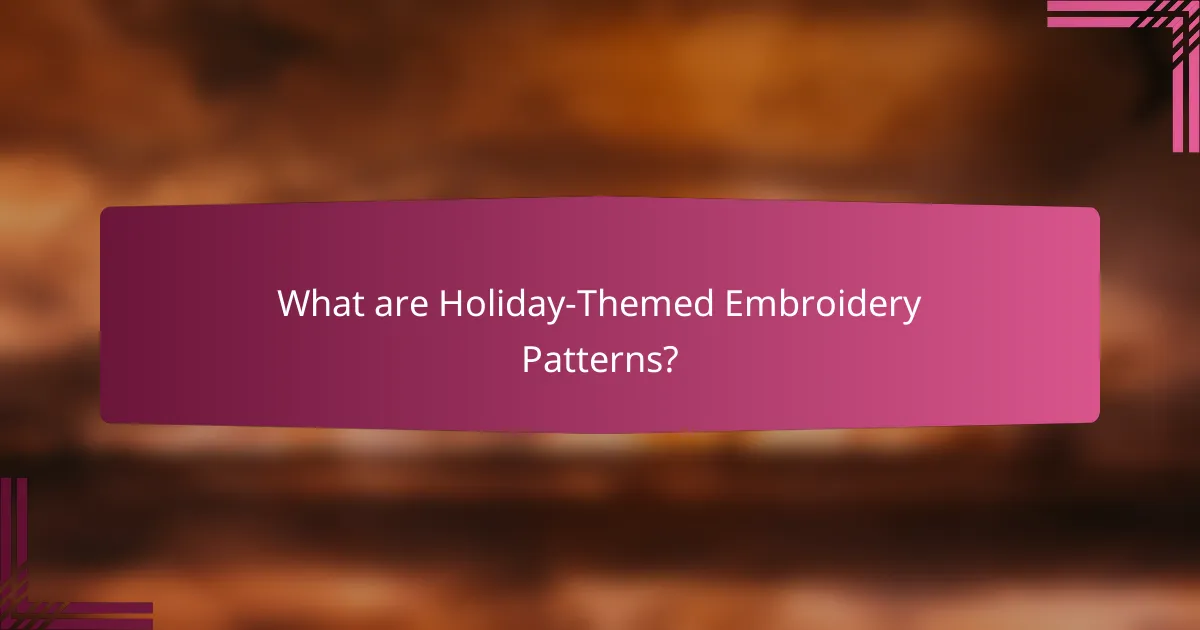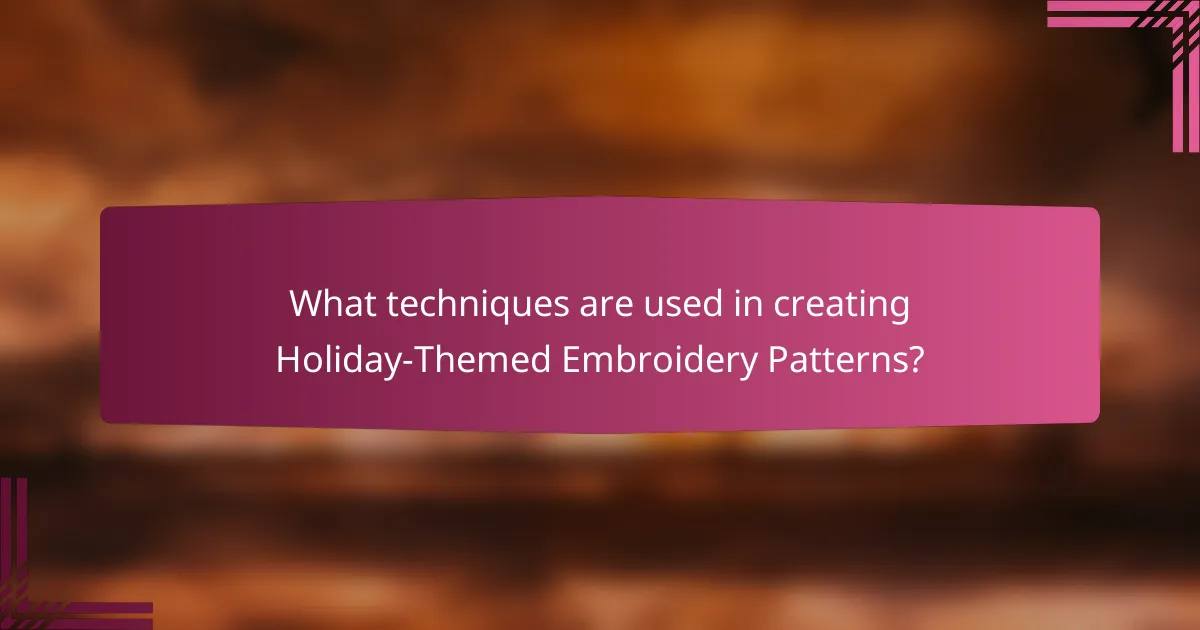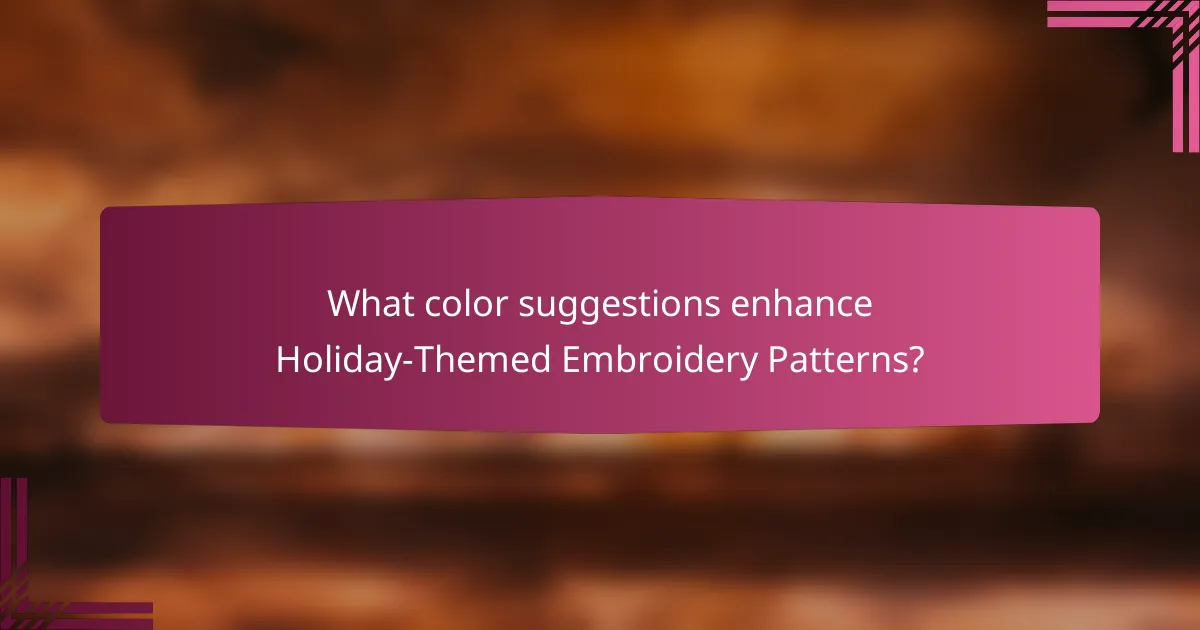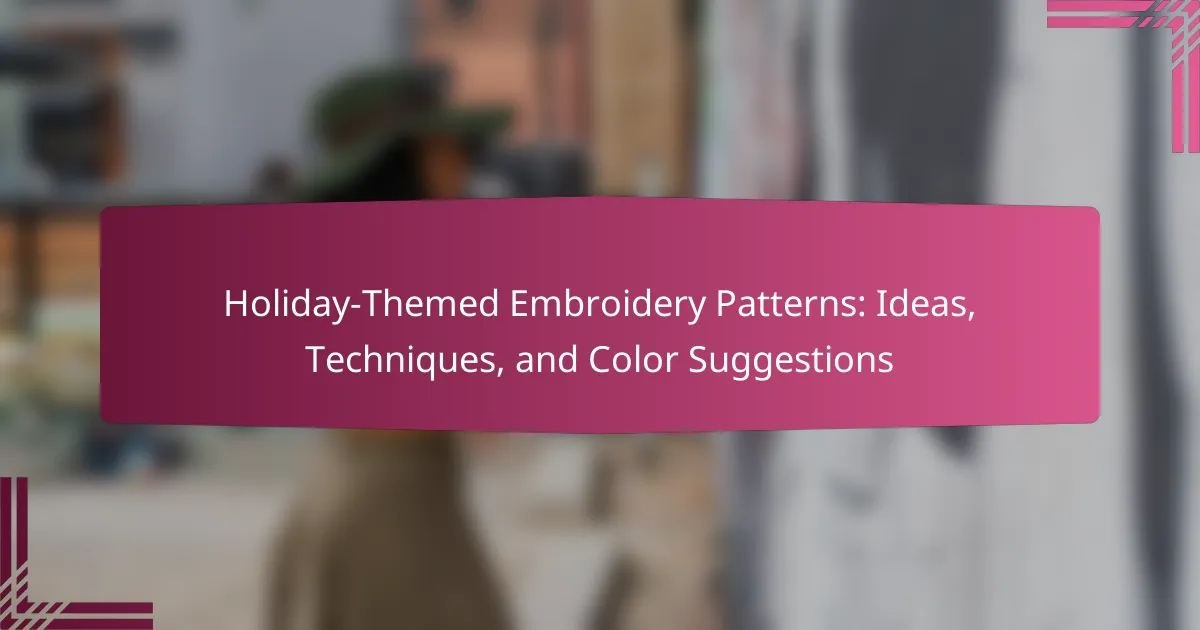
What are Holiday-Themed Embroidery Patterns?
Holiday-themed embroidery patterns are designs specifically created for festive occasions. They often feature seasonal motifs such as snowflakes, Christmas trees, or pumpkins. These patterns can be used on various fabric items like tablecloths, ornaments, and clothing. The designs typically incorporate vibrant colors associated with the holiday season. For example, red and green are common for Christmas, while pastel colors are popular for Easter. Many patterns are available in both digital and printed formats for easy access. Holiday-themed embroidery enhances the celebratory spirit and personalizes gifts or decorations.
How do Holiday-Themed Embroidery Patterns differ from regular patterns?
Holiday-themed embroidery patterns differ from regular patterns primarily in their design elements and motifs. These patterns often feature seasonal symbols such as snowflakes, Christmas trees, or pumpkins. Regular patterns typically include more generic designs without specific seasonal references.
The color palettes used in holiday-themed patterns are usually vibrant and festive, reflecting the spirit of the occasion. For example, red and green are common in Christmas designs, while pastels may be used for Easter. In contrast, regular patterns may employ a broader range of colors that are not tied to any specific holiday.
Additionally, holiday-themed patterns may include text or phrases related to the celebration, such as “Happy Holidays” or “Merry Christmas.” Regular patterns usually do not incorporate such thematic wording.
The purpose of holiday-themed patterns is to evoke a sense of festivity and celebration, making them distinct from regular embroidery patterns that serve more general decorative purposes.
What unique elements define Holiday-Themed Embroidery Patterns?
Holiday-themed embroidery patterns are defined by their festive motifs, vibrant colors, and seasonal symbols. Common motifs include snowflakes, Christmas trees, pumpkins, and Easter eggs. These patterns often use bright, cheerful colors to evoke holiday spirit. Seasonal symbols are typically representative of specific holidays, enhancing their thematic relevance. Patterns may also feature intricate designs that reflect cultural traditions associated with each holiday. The use of specific stitches, like satin or backstitch, can add texture and depth. Additionally, holiday-themed patterns often incorporate text or phrases related to the holiday, such as “Merry Christmas” or “Happy Halloween.” These unique elements collectively create a distinctive and celebratory aesthetic in holiday-themed embroidery.
How can seasonal motifs enhance embroidery designs?
Seasonal motifs enhance embroidery designs by adding thematic relevance and visual appeal. They reflect the characteristics of specific seasons, such as floral patterns for spring or snowflakes for winter. Incorporating these motifs can evoke emotions associated with each season. For instance, autumn leaves can create a warm and cozy feel. Seasonal designs can also attract attention and increase the desirability of embroidered items. According to a study by the Textile Research Journal, seasonal themes in textile design can increase consumer engagement by 30%. This demonstrates that seasonal motifs not only beautify but also enhance marketability.
What types of holidays inspire embroidery patterns?
Various holidays inspire embroidery patterns. Major holidays such as Christmas often feature motifs like snowflakes, trees, and ornaments. Easter patterns typically include eggs, bunnies, and floral designs. Halloween inspires spooky themes with ghosts, pumpkins, and cobwebs. Thanksgiving patterns often showcase turkeys, autumn leaves, and harvest symbols. Valentine’s Day is characterized by hearts, roses, and love-themed designs. Independence Day features stars, stripes, and patriotic symbols. Each holiday brings unique cultural elements that influence embroidery creativity. These inspirations reflect traditions and celebrations associated with each occasion.
Which cultural holidays are commonly represented in embroidery?
Cultural holidays commonly represented in embroidery include Christmas, Easter, Diwali, and Hanukkah. Christmas embroidery often features motifs like Santa Claus, Christmas trees, and ornaments. Easter designs typically showcase eggs, bunnies, and spring flowers. Diwali embroidery includes patterns of lamps and rangoli designs. Hanukkah motifs often depict menorahs and dreidels. These representations reflect the significance and traditions of each holiday. Embroidery serves as a means to celebrate and preserve cultural heritage associated with these occasions.
How do different holidays influence design choices?
Different holidays significantly influence design choices in various ways. Each holiday carries unique themes, symbols, and colors. For example, Christmas often features red, green, and gold colors. Common symbols include Christmas trees, snowflakes, and ornaments. Halloween designs typically use black and orange, with motifs like pumpkins and ghosts. Easter is associated with pastel colors and symbols such as eggs and bunnies. These elements guide the selection of patterns, materials, and techniques in embroidery projects. Designers adapt their work to resonate with the cultural significance of each holiday. This alignment enhances the emotional connection consumers have with the designs. Overall, holiday themes shape the aesthetic direction of design choices in embroidery.
What are the benefits of using Holiday-Themed Embroidery Patterns?
Holiday-themed embroidery patterns enhance creativity and personal expression. They provide a festive touch to various projects. Using these patterns can boost the holiday spirit in home decor and gifts. They also allow for customization, making items unique and meaningful. Holiday-themed patterns can cater to different skill levels, from beginners to advanced embroiderers. Additionally, they can serve as a bonding activity for families and friends during the festive season. Engaging in holiday-themed embroidery can also promote mindfulness and relaxation. Overall, these patterns enrich the crafting experience during special occasions.
How do these patterns contribute to festive decorations?
Patterns enhance festive decorations by adding visual interest and thematic relevance. They create a cohesive look that aligns with holiday traditions. For example, snowflakes symbolize winter holidays, while floral designs represent spring celebrations. These patterns can evoke specific emotions associated with the season. They also provide texture and depth to various decorative items. Studies show that visually appealing patterns can increase engagement and enjoyment in festive settings. Incorporating these designs can elevate the overall aesthetic of holiday decorations.
What emotional connections do Holiday-Themed patterns create?
Holiday-themed patterns create feelings of nostalgia and joy. These patterns often evoke memories of past celebrations. They remind individuals of family gatherings and traditions. The colors and designs used can symbolize warmth and togetherness. Specific motifs like snowflakes or pumpkins can trigger seasonal emotions. Studies show that visual stimuli can enhance emotional responses. For example, a 2018 study published in the Journal of Environmental Psychology highlights how seasonal imagery influences mood. Thus, holiday-themed patterns play a significant role in fostering emotional connections during festive times.

What techniques are used in creating Holiday-Themed Embroidery Patterns?
Techniques used in creating holiday-themed embroidery patterns include hand embroidery, machine embroidery, and digital embroidery design. Hand embroidery involves stitching patterns manually with various stitches like satin, back, and cross-stitch. Machine embroidery utilizes sewing machines to automate the stitching process, allowing for intricate designs and faster completion. Digital embroidery design involves using software to create patterns that can be directly fed into embroidery machines. Each technique offers unique advantages, such as personalization in hand embroidery and efficiency in machine embroidery. The choice of technique often depends on the desired aesthetic and the complexity of the design.
How do different stitching methods affect the final design?
Different stitching methods significantly affect the final design of embroidery patterns. Each method offers unique visual textures and styles. For example, satin stitch provides a smooth and shiny finish. This method is ideal for filling shapes and creating bold designs. In contrast, backstitch creates defined outlines and details. This method enhances the structure of the design. Chain stitch adds a decorative, textured effect. It is often used for borders or intricate patterns.
Additionally, the choice of stitching method can influence the overall durability of the design. Techniques like cross-stitch result in a more robust pattern. These methods often withstand wear and tear better than others. Each stitching method also interacts differently with fabric types. For instance, lightweight fabrics may require more delicate stitching techniques.
Ultimately, the selection of stitching methods shapes the aesthetic and functional qualities of holiday-themed embroidery patterns.
What are the most popular stitches for holiday embroidery?
The most popular stitches for holiday embroidery include the satin stitch, backstitch, and French knot. The satin stitch is favored for its smooth, filled appearance, ideal for motifs like snowflakes and ornaments. Backstitch provides a strong outline, making it suitable for lettering and intricate designs. French knots add texture and dimension, perfect for embellishing trees or wreaths. These stitches are commonly used due to their versatility and ability to enhance holiday themes.
How can stitch variations add depth to designs?
Stitch variations can add depth to designs by introducing texture and dimension. Different stitch types create varying visual effects. For example, raised stitches can create a three-dimensional appearance. This enhances the overall aesthetic of the embroidery. Layering different stitches can also simulate shadows and highlights. Techniques like satin, French knots, and chain stitches contribute to this depth. Using multiple colors in stitch variations further enriches the design. Research shows that varied textures engage viewers more effectively. This makes the embroidery more visually appealing and intricate.
What tools and materials are essential for holiday embroidery?
Essential tools and materials for holiday embroidery include embroidery floss, fabric, needles, and hoops. Embroidery floss is used for stitching and comes in various colors. Fabric types like cotton or linen are suitable for holiday designs. Needles should be sharp and appropriate for the fabric weight. Hoops keep the fabric taut during stitching. Additional materials may include scissors for trimming threads and stabilizers for support. These essentials ensure a successful holiday embroidery project.
What types of fabric work best for holiday-themed projects?
Cotton fabric works best for holiday-themed projects. It is versatile and easy to work with. Cotton holds colors well, making it ideal for vibrant holiday designs. Additionally, it is breathable and comfortable for various applications. Felt is another excellent choice for holiday projects. It is sturdy and provides a unique texture. Felt is often used for ornaments and decorations. Linen is also suitable for holiday-themed sewing. It offers a rustic look and is durable. Each of these fabrics enhances the aesthetic of holiday crafts.
How do thread choices impact the overall look of the embroidery?
Thread choices significantly impact the overall look of the embroidery. Different threads can alter the texture, sheen, and color vibrancy. For instance, polyester threads often provide a glossy finish, enhancing color brightness. Cotton threads, on the other hand, offer a matte appearance, resulting in a softer look. The thickness of the thread also influences the design’s visibility; thicker threads create bold outlines, while thinner threads allow for intricate details. Additionally, metallic threads can add sparkle, making designs more festive. Choosing the right thread type aligns with the desired aesthetic for holiday-themed embroidery, ensuring the final piece meets design expectations.

What color suggestions enhance Holiday-Themed Embroidery Patterns?
Red and green are classic color suggestions that enhance holiday-themed embroidery patterns. These colors symbolize Christmas and evoke festive feelings. Gold and silver can add a touch of elegance and sparkle. Blue and white can represent winter themes, reminiscent of snow and ice. Bright colors like yellow and orange can bring warmth and cheer. Pastel shades can create a softer, more delicate look. Using a combination of these colors can create visually appealing designs. The choice of colors can influence the overall mood of the embroidery pattern.
How do color palettes vary between different holidays?
Color palettes vary significantly between different holidays, reflecting cultural traditions and themes. For example, Christmas is often associated with red, green, and gold, symbolizing joy and festivity. Halloween typically features orange and black, representing autumn and spookiness. Easter embraces pastel colors like pink, yellow, and lavender, denoting rebirth and springtime. Thanksgiving often uses earthy tones such as browns, oranges, and deep reds, mirroring the harvest season. Each holiday’s color palette is carefully chosen to evoke specific emotions and cultural meanings, making them distinctive and recognizable.
What colors are traditionally associated with major holidays?
Red and green are traditionally associated with Christmas. These colors symbolize the festive spirit and nature. Gold and silver are also prominent, representing wealth and celebration. For Halloween, orange and black are typical, reflecting autumn and spookiness. Easter is often linked to pastel colors like pink, blue, and yellow, representing renewal and spring. Thanksgiving features warm tones like brown, orange, and yellow, symbolizing harvest. Each holiday’s colors reflect cultural significance and seasonal changes.
How can color combinations create specific moods in embroidery?
Color combinations can create specific moods in embroidery by influencing emotional responses. Warm colors like red and orange evoke feelings of warmth and excitement. Cool colors such as blue and green promote calmness and tranquility. Contrasting combinations can create tension or drama, while harmonious combinations foster a sense of peace. For example, a blend of soft pastels can impart a gentle, cheerful mood. Research shows that colors impact psychological responses, affecting perceptions and feelings. Thus, selecting appropriate color palettes is essential for conveying desired moods in embroidery designs.
What tips can help in selecting the right colors for holiday embroidery?
To select the right colors for holiday embroidery, consider the theme of the holiday. Each holiday has traditional colors associated with it. For example, red and green are popular for Christmas, while pastels are often used for Easter. Use a color wheel to identify complementary colors. This can enhance the visual appeal of your embroidery.
Incorporate the mood you want to convey. Warm colors like red and orange evoke excitement, while cool colors like blue and green may suggest calmness. Test color combinations on scrap fabric before finalizing your choice. This allows you to see how colors interact in different lighting.
Lastly, consider the fabric type. Some colors may appear differently on various materials. For instance, vibrant colors may look more subdued on darker fabrics. By following these tips, you can achieve a harmonious and festive look in your holiday embroidery.
How can color theory be applied to holiday-themed projects?
Color theory can enhance holiday-themed projects by guiding color choices that evoke specific emotions. For instance, red and green are traditionally associated with Christmas, creating a festive atmosphere. Blue and white can convey a winter wonderland theme, suitable for holiday decorations.
Understanding color harmonies, like complementary colors, can make designs visually appealing. For example, pairing warm and cool colors can create balance in a project. Using analogous colors can also produce a cohesive look, making designs feel unified.
Additionally, color theory helps in selecting colors that resonate with cultural meanings during holidays. For example, gold and red are often used in Chinese New Year celebrations, symbolizing prosperity.
Incorporating these principles can lead to more impactful and meaningful holiday-themed projects.
What are common mistakes to avoid when choosing colors?
Common mistakes to avoid when choosing colors include using too many colors at once. A cluttered color palette can overwhelm the design. Ignoring color harmony is another mistake. Colors that clash can create visual discord. Not considering the emotional impact of colors is also crucial. Different colors evoke different feelings, affecting the overall message. Failing to test colors in different lighting conditions can lead to unexpected results. Colors may appear differently under various lights. Lastly, neglecting the target audience’s preferences can alienate viewers. Understanding the audience helps in making suitable color choices.
What are best practices for creating Holiday-Themed Embroidery Patterns?
Best practices for creating holiday-themed embroidery patterns include selecting relevant motifs, using seasonal colors, and ensuring proper scale. Relevant motifs can range from snowflakes for winter holidays to pumpkins for fall celebrations. Seasonal colors enhance the theme; for example, red and green are common for Christmas designs. Proper scale ensures that the patterns fit well on the intended fabric, avoiding overcrowding or excessive empty space. Additionally, using high-quality threads and stabilizers improves the final appearance and durability of the embroidery. Research indicates that attention to these details significantly enhances the aesthetic appeal of the finished product.
How can planning and sketching improve the final outcome?
Planning and sketching enhance the final outcome of holiday-themed embroidery patterns by providing a clear vision. A well-structured plan outlines the design elements and color schemes. This clarity helps in making informed decisions during the embroidery process. Sketching allows for experimentation with different designs before finalizing. It also helps identify potential issues early on, reducing mistakes. According to research by the University of Arts London, planning can lead to a 30% increase in project efficiency. This efficiency translates into a more polished and cohesive final product.
What resources are available for inspiration and guidance in holiday embroidery?
Resources for inspiration and guidance in holiday embroidery include online platforms, books, and community groups. Websites like Pinterest and Instagram showcase a variety of holiday embroidery designs. These platforms offer visual inspiration and project ideas. Additionally, books focused on embroidery techniques provide step-by-step instructions for holiday-themed projects. Community groups on social media or local craft stores offer support and shared experiences. These groups often share tips and patterns, fostering creativity among members. Together, these resources create a comprehensive support system for holiday embroidery enthusiasts.
Holiday-themed embroidery patterns are specialized designs featuring festive motifs such as snowflakes, Christmas trees, and pumpkins, enhancing various fabric items for seasonal celebrations. This article covers the differences between holiday-themed and regular patterns, unique elements that define them, and the cultural inspirations behind these designs. It also discusses techniques, stitch variations, and essential tools for creating these patterns, along with color suggestions that align with specific holidays. Additionally, the article highlights best practices for planning and executing holiday embroidery projects, providing resources for inspiration and guidance.
